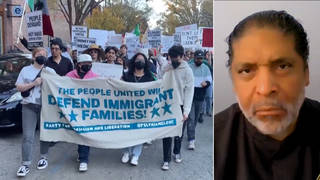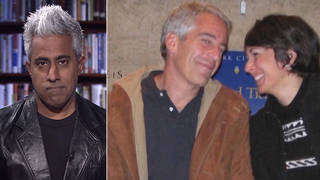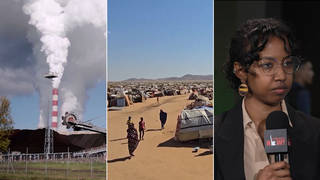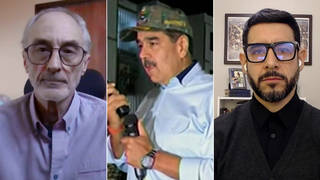
We broadcast from Las Vegas, which is hosting the 2010 Netroots Nation. Thousands of people are attending, including Democrats in Congress, policy speakers, progressive bloggers and more. Among them is urban environmentalist Majora Carter. Newsweek has named her one of “25 to Watch” and one of the “century’s most important environmentalists.” She is currently president of the green-collar economic consulting firm the Majora Carter Group. In 2006, Majora Carter gave a rousing address at TED Talks about her life and her work. [includes rush transcript]
Transcript
AMY GOODMAN: We’re broadcasting from Las Vegas, which is hosting the 2010 Netroots Nation. The conference opens today at the Rio hotel and casino. Thousands of people are attending, including a number of Democrats in Congress, policy speakers, progressive bloggers and more. Among them is urban environmentalist Majora Carter. Newsweek has named her one of “25 to Watch” and one of the “century’s most important environmentalists.” She is currently president of the green-collar economic consulting firm the Majora Carter Group.
In 2006, Majora Carter gave a rousing address at TED Talks. She talks about her life and her work. This is Majora Carter.
MAJORA CARTER: If you’re here today — and I’m very happy that you are — you’ve all heard about how sustainable development will save us from ourselves. However, when we’re not at TED, we are often told that a real sustainability policy agenda is just not feasible, especially in large urban areas like New York City. And that’s because most people with decision-making powers, in both the public and the private sector, really don’t feel as though they’re in danger.
The reason why I’m here today, in part, is because of a dog, an abandoned puppy I found back in the rain, back in 1998. She turned out to be a much bigger dog than I’d anticipated. When she came into my life, we were fighting against a huge waste facility planned for the East River waterfront, despite the fact that our small part of New York City was — already handled more than 40 percent of the entire city’s commercial waste, a sewage treatment pelletizing plant, a sewage sludge plant, four power plants, the world’s largest food distribution center, as well as other industries that bring more than 60,000 diesel truck trips to the area each week.
The area also has one of the lowest ratios of parks to people in the city. So when I was contacted by the Parks Department about a $10,000 seed grant initiative to help develop waterfront projects, I thought they were really well-meaning, but a bit naive. I had lived in this area all my life and knew you could not get to the river because of all the lovely facilities that I’d mentioned earlier.
Then, while jogging with my dog one morning, she pulled me into what I thought was just another illegal dump. There were weeds and piles of garbage and other stuff that I won’t mention here, but she kept dragging me. And lo and behold, at the end of that lot was the river. I knew that this forgotten little street end, abandoned like the dog that brought me there, was worth saving, and I knew it would grow to become the proud beginnings of the community-led revitalization of the new South Bronx. And just like my new dog, it was an idea that got bigger than I’d imagined.
We garnered much support along the way. And the Hunts Point Riverside Park became the first waterfront park that the South Bronx had had in more than sixty years. We leveraged that $10,000 seed grant more than 300 times into a $3 million park. And in the fall, I’m actually going to — I exchanged marriage vows with my beloved — thank you very much. That’s him pressing my buttons back there, which he does all the time.
But those of us living in environmental justice communities are the canary in the coal mine. We feel the problems right now, and have for some time. Environmental justice, for those of you who may not be familiar with the term, goes something like this: No community should be saddled with more environmental burdens and less environmental benefits than any other. Unfortunately, race and class are extremely reliable indicators as to where one might find the good stuff, like parks and trees, and where one might find the bad stuff, like power plants and waste facilities. As a black person in America, I am twice as likely as a white person to live in an area where air pollution poses the greatest risk to my health. I am five times more likely to live within walking distance of a power plant or a chemical facility, which I do.
These land-use decisions created the hostile conditions that lead to problems like obesity, diabetes and asthma. Why would someone leave their home to go for a brisk walk in a toxic neighborhood? Our 27 percent obesity rate is high even for this country, and diabetes comes with it. One out of four South Bronx children has asthma. Our asthma hospitalization rate is seven times higher than the national average. These impacts are coming everyone’s way.
And we all pay dearly for solid waste costs, health problems associated with pollution, and, more odiously, the cost of imprisoning our young black and Latino men, who possess untold amounts of untapped potential. Fifty percent of our residents live at or below the poverty line. Twenty-five percent of us are unemployed. Low-income citizens often use emergency room visits as primary care. This comes at a high cost to taxpayers and produces no proportional benefits. Poor people are not only still poor, they are still unhealthy.
Fortunately, there are many people like me who are striving for solutions that won’t compromise the lives of low-income communities of color in the short term, and won’t destroy us all in the long term. None of us want that, and we all have that in common.
So what else do we have in common? Well, first of all, we’re all incredibly good-looking, graduated high school, college, post-graduate degrees, traveled to interesting places, didn’t have kids in your early teens, financially stable, never been imprisoned. OK. Good.
But besides being a black woman, I am different from most of you in some other ways. I watched nearly half of the buildings in my neighborhood burn down. My big brother Lenny fought in Vietnam, only to be gunned down a few blocks from our home. Jesus. I grew up with a crack house across the street. Yeah, I’m a poor black child from the ghetto. These things make me different from you. But the things we have in common set me apart from most of the people in my community, and I am in between these two worlds, with enough of my heart to fight for justice in the other.
So how did things get so different for us? In the late '40s, my dad, a Pullman porter, son of a slave, bought a house in the Hunts Point section of the South Bronx, and a few years later he married my mom. At the time, the community was a mostly white, working-class neighborhood. My dad was not alone, and as others like him pursued their own version of the American dream, white flight became common in the South Bronx and in many cities around the country. Red-lining was used by banks, wherein certain sections of the city, including ours, were deemed off-limits to any sort of investment. Many landlords believed it was more profitable to torch their buildings and collect insurance money, rather than to sell under those conditions, dead or injured former tenants notwithstanding.
Hunts Point was formerly a walk-to-work community, but now residents had neither work nor home to walk to. A national highway construction boom was added to our problems. In New York state, Robert Moses spearheaded an aggressive highway expansion campaign. One of its primary goals was to make it easier for residents of wealthy communities in Westchester County to go to Manhattan. The South Bronx, which lies in between, did not stand a chance. Residents were often given less than a month's notice before their buildings were razed. 600,000 people were displaced.
The common perception was that only pimps and pushers and prostitutes were from the South Bronx. And if you are told from your earliest days that nothing good is going to come from your community, that it is bad and ugly, how could it not reflect on you?
So now my family’s property was worthless, save for that it was our home and all we had. And luckily for me, that home and the love inside of it, along with help from teachers, mentors and friends along the way, was enough.
Now why is this story important? Because from a planning perspective, economic degradation begets environmental degradation, which begets social degradation. The disinvestment that began in the 1960s set the stage for all the environmental injustices that were to come. Antiquated zoning and land-use regulations are still used to this day to continue putting polluting facilities in my neighborhood.
Are these factors taken into consideration when land-use policy is decided? What costs are associated with these decisions? And who pays? Who profits? Does anything justify what the local community goes through? This was “planning” — in quotes — that did not have our best interests in mind.
Once we realized that, we decided it was time to do our own planning. That small park I told you about earlier was the first stage of building a greenway movement in the South Bronx. I wrote a one-and-a-quarter-million-dollar federal transportation grant to design the plan for a waterfront esplanade with dedicated on-street bike paths.
Physical improvements help inform public policy regarding traffic safety, the placement of the waste and other facilities, which, if done properly, don’t compromise a community’s quality of life. They provide opportunities to be more physically active, as well as local economic development. Think bike shops, juice stands.
We secured $20 million to build first-phase projects. This is Lafayette Avenue, and as redesigned by Matthews-Nielsen landscape architects, and once this path is constructed, it’ll connect the South Bronx with more than 400 acres of Randall’s Island Park. Right now we’re separated by about twenty-five feet of water, but this link will change that. And as we nurture the natural environment, its abundance will give us back even more.
We run a project called the Bronx Ecological Stewardship Training, which provides job training in the fields of ecological restoration, so that folks from our community have the skills to compete for these well-paying jobs. Little by little, we’re seeding the area with green-collar jobs, that has both — the people that have both a financial and personal stake in their environment.
The Sheridan Expressway is an underutilized relic of the Robert Moses era, built with no regard for the neighborhoods that were divided by it. Even during rush hour, it goes virtually unused. The community created an alternative transportation plan that allows for the removal of the highway. We have the opportunity now to bring together all the stakeholders to re-envision how this twenty-eight acres can be better utilized for parkland, affordable housing, and local economic development.
We also built the city’s — New York City’s first green and “cool-roof” demonstration project on top of our offices. “Cool roofs” are highly reflective surfaces that don’t absorb solar heat and pass it on to the building or atmosphere. “Green roofs” are soil and living plants. Both can be used instead of petroleum-based roofing materials that absorb heat, contribute to the urban “heat island” effect, and degrade under the sun, which we in turn breathe. Green roofs also retain up to 75 percent of rainfall, so they reduce a city’s need to fund costly end-of-pipe solutions, which, incidentally, are often located in environmental justice communities like mine. And they provide habitats for our little friends! So, so cool!
Anyway, the demonstration project is a springboard for our own green roof installation business, bringing jobs and sustainable economic activity to the South Bronx. I like that, too. Anyway, I know Chris told us not to do pitches up here, but since I have all of your attention, we need investors. End of pitch. It’s better to ask for forgiveness than permission, anyway.
OK, Katrina. Prior to Katrina, the South Bronx and New Orleans Ninth Ward had a lot in common. Both were largely populated by poor people of color, both hotbeds of cultural innovation. Think hip-hop and jazz. Both are waterfront communities that host both industries and residents in close proximity of one another. In the post-Katrina era, we have still more in common. We’re, at best, ignored, and maligned and abused, at worst, by negligent regulatory agencies, pernicious zoning and lax governmental accountability.
Neither the destruction of the Ninth Ward nor the South Bronx was inevitable. But we have emerged with valuable lessons about how to dig ourselves out. We are more than simply national symbols of urban blight or problems to be solved by empty campaign promises of presidents come and gone. Now, will we let the Gulf Coast languish for a decade or two like the South Bronx did, or will we take proactive steps and learn from the homegrown resource of grassroots activists that have been born of desperation in communities like mine?
Now, listen, I do not expect individuals, corporations or government to make the world a better place because it is right or moral. This presentation today only represents some of what I’ve been through, like a tiny little bit. You have no clue. But I’ll tell you later if you want to know. But I know it’s the bottom line, or one’s perception of it, that motivates people in the end. I’m interested in what I like to call the triple bottom line that sustainable development can produce: developments that have the potential to create positive returns for all concerned — the developers, government and the community where these projects go up.
At present, that’s not happening in New York CIty. And we are operating with a comprehensive urban planning deficit. A parade of government subsidies is going to proposed big-box and stadium developments in the South Bronx, but there is scant coordination between city agencies on how to deal with the cumulative effects of increased traffic, pollution, solid waste and the impacts on open space. And their approaches to local economic and job development are so lame it’s not even funny. Because, on top of that, the richest — the world’s richest — sports team is replacing the House that Ruth Built by destroying two well-loved community parks, now we’ll have even less than that stat I told you about earlier. And although less than 25 percent of South Bronx residents own cars, these projects include thousands of new parking spaces, yet zip in terms of mass public transit. Now, what’s missing from the larger debate is a comprehensive cost-benefit analysis between not fixing an unhealthy, environmentally challenged community, versus incorporating structural, sustainable changes. My agency is working closely with Columbia University and others to shine a light on these issues.
Now, let’s get this straight: I am not anti-development. Ours is a city, not a wilderness preserve. And I’ve embraced my inner capitalist. But I don’t have — you probably all have, and if you haven’t, you need to. So I don’t have a problem with developers making money. There’s enough precedent out there to show that a sustainable, community-friendly development can still make a fortune. You know, fellow TEDsters Bill McDonough and Emery Lovins, both heroes of mine, by the way, have shown that you can actually do that. I do have a problem with developments that hyper-exploit politically vulnerable communities for profit. That it continues is a shame upon us all, because we are all responsible for the future that we create.
But one of the things I do to remind myself of greater possibilities is to learn from visionaries in other cities. This is my version of globalization: Let’s take Bogotá — poor, Latino, surrounded by runaway gun violence and drug trafficking, a reputation not unlike that of the South Bronx. However, this city was blessed in the late 1990s with a highly influential mayor named Enrique Peñalosa. He looked at the demographics. Few Bogatanos own cars, yet a huge portion of the city’s resources was dedicated to serving them. If you’re mayor, you can do something about that. His administration narrowed key municipal thoroughfares from five lanes to three, outlawed parking on those streets, expanded pedestrian walkways and bike lanes, created public plazas, created one of the most efficient bus mass transit systems in the entire world.
For his brilliant efforts, he was nearly impeached. But as people began to see that they were being put first on issues reflecting their day-to-day lives, incredible things happened. People stopped littering. Crime rates dropped, because the streets were alive with people. His administration attacked several typical urban problems at one time, and on a third-world budget at that. We have no excuse in this country, I’m sorry. But the bottom line is, their people-first agenda was not meant to penalize those who could actually afford cars, but rather to provide opportunities for all Bogatanos to participate in the city’s resurgence. That development should not come at the expense of the majority of the population is still considered a radical idea here in the US. But Bogotá’s example has the power to change that.
You, however, are blessed with the gift of influence. That’s why you’re here and why you value the information we exchange. Use your influence in support of comprehensive sustainable change everywhere. Don’t just talk about it at TED. This is a nationwide policy agenda I’m trying to build, and as you all know, politics are personal. Help me make green the new black. Help me make sustainability sexy. Make it a part of your dinner and cocktail conversations. Help me fight for environmental and economic justice. Support investments with a triple-bottom-line return. Help me democratize sustainability by bringing everyone to the table and insisting that comprehensive planning can be addressed everywhere.
Oh, good, glad I have a little more time.
Listen, when I spoke to Mr. Gore the other day after breakfast, I asked him how environmental justice activists were going to be included in his new marketing strategy. His response was a grant program. I don’t think he understood that I wasn’t asking for funding. I was making him an offer. What troubled me was that this top-down approach is still around. Now, don’t get me wrong, we need money. But grassroots groups are needed at the table during the decision-making process. Of the 90 percent of the energy that Mr. Gore reminded us that we waste every day, don’t add wasting our energy, intelligence and hard-earned experience to that count. I have come from so far to meet you like this. Please don’t waste me. By working together, we can become one of those small, rapidly growing groups of individuals who actually have the audacity and courage to believe that we actually can change the world. We might have come to this conference from very, very different stations in life, but believe me, we all share one incredibly powerful thing: We have nothing to lose and everything to gain.
Ciao, bellos!
AMY GOODMAN: Majora Carter, currently the president of the green-collar economic consulting firm the Majora Carter Group. She founded Sustainable South Bronx, a nonprofit environmental justice group. This speech was her TED Talk. She gave it in 2006. She’ll be appearing here in Las Vegas at Netroots Nation. TED Talks you can find at ted.com.












Media Options